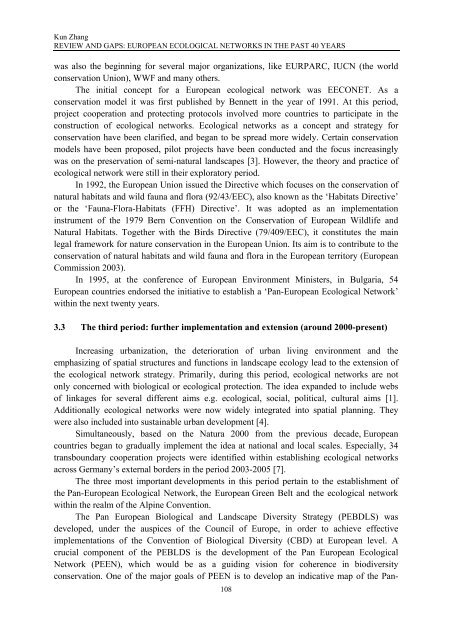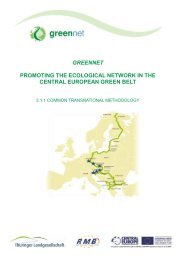The Green Belt as a European Ecological Network strengths and gaps
The Green Belt as a European Ecological Network strengths and gaps
The Green Belt as a European Ecological Network strengths and gaps
You also want an ePaper? Increase the reach of your titles
YUMPU automatically turns print PDFs into web optimized ePapers that Google loves.
Kun Zhang<br />
REVIEW AND GAPS: EUROPEAN ECOLOGICAL NETWORKS IN THE PAST 40 YEARS<br />
w<strong>as</strong> also the beginning for several major organizations, like EURPARC, IUCN (the world<br />
conservation Union), WWF <strong>and</strong> many others.<br />
<strong>The</strong> initial concept for a <strong>European</strong> ecological network w<strong>as</strong> EECONET. As a<br />
conservation model it w<strong>as</strong> first published by Bennett in the year of 1991. At this period,<br />
project cooperation <strong>and</strong> protecting protocols involved more countries to participate in the<br />
construction of ecological networks. <strong>Ecological</strong> networks <strong>as</strong> a concept <strong>and</strong> strategy for<br />
conservation have been clarified, <strong>and</strong> began to be spread more widely. Certain conservation<br />
models have been proposed, pilot projects have been conducted <strong>and</strong> the focus incre<strong>as</strong>ingly<br />
w<strong>as</strong> on the preservation of semi-natural l<strong>and</strong>scapes [3]. However, the theory <strong>and</strong> practice of<br />
ecological network were still in their exploratory period.<br />
In 1992, the <strong>European</strong> Union issued the Directive which focuses on the conservation of<br />
natural habitats <strong>and</strong> wild fauna <strong>and</strong> flora (92/43/EEC), also known <strong>as</strong> the ‘Habitats Directive’<br />
or the ‘Fauna-Flora-Habitats (FFH) Directive’. It w<strong>as</strong> adopted <strong>as</strong> an implementation<br />
instrument of the 1979 Bern Convention on the Conservation of <strong>European</strong> Wildlife <strong>and</strong><br />
Natural Habitats. Together with the Birds Directive (79/409/EEC), it constitutes the main<br />
legal framework for nature conservation in the <strong>European</strong> Union. Its aim is to contribute to the<br />
conservation of natural habitats <strong>and</strong> wild fauna <strong>and</strong> flora in the <strong>European</strong> territory (<strong>European</strong><br />
Commission 2003).<br />
In 1995, at the conference of <strong>European</strong> Environment Ministers, in Bulgaria, 54<br />
<strong>European</strong> countries endorsed the initiative to establish a ‘Pan-<strong>European</strong> <strong>Ecological</strong> <strong>Network</strong>’<br />
within the next twenty years.<br />
3.3 <strong>The</strong> third period: further implementation <strong>and</strong> extension (around 2000-present)<br />
Incre<strong>as</strong>ing urbanization, the deterioration of urban living environment <strong>and</strong> the<br />
emph<strong>as</strong>izing of spatial structures <strong>and</strong> functions in l<strong>and</strong>scape ecology lead to the extension of<br />
the ecological network strategy. Primarily, during this period, ecological networks are not<br />
only concerned with biological or ecological protection. <strong>The</strong> idea exp<strong>and</strong>ed to include webs<br />
of linkages for several different aims e.g. ecological, social, political, cultural aims [1].<br />
Additionally ecological networks were now widely integrated into spatial planning. <strong>The</strong>y<br />
were also included into sustainable urban development [4].<br />
Simultaneously, b<strong>as</strong>ed on the Natura 2000 from the previous decade, <strong>European</strong><br />
countries began to gradually implement the idea at national <strong>and</strong> local scales. Especially, 34<br />
transboundary cooperation projects were identified within establishing ecological networks<br />
across Germany’s external borders in the period 2003-2005 [7].<br />
<strong>The</strong> three most important developments in this period pertain to the establishment of<br />
the Pan-<strong>European</strong> <strong>Ecological</strong> <strong>Network</strong>, the <strong>European</strong> <strong>Green</strong> <strong>Belt</strong> <strong>and</strong> the ecological network<br />
within the realm of the Alpine Convention.<br />
<strong>The</strong> Pan <strong>European</strong> Biological <strong>and</strong> L<strong>and</strong>scape Diversity Strategy (PEBDLS) w<strong>as</strong><br />
developed, under the auspices of the Council of Europe, in order to achieve effective<br />
implementations of the Convention of Biological Diversity (CBD) at <strong>European</strong> level. A<br />
crucial component of the PEBLDS is the development of the Pan <strong>European</strong> <strong>Ecological</strong><br />
<strong>Network</strong> (PEEN), which would be <strong>as</strong> a guiding vision for coherence in biodiversity<br />
conservation. One of the major goals of PEEN is to develop an indicative map of the Pan-<br />
108




